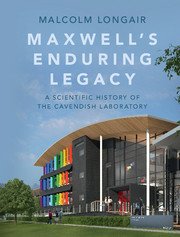Book contents
- Frontmatter
- Dedication
- Contents
- Preface
- Acknowledgements
- Part I To 1874
- Part II 1874 to 1879
- Part III 1879 to 1884
- Part IV 1884 to 1919
- Part V 1919 to 1937
- 8 Rutherford at McGill and Manchester universities: new challenges in Cambridge
- 9 The Rutherford era: the radioactivists
- 10 The Rutherford era: the seeds of the new physics
- Part VI 1938 to 1953
- Part VII 1953 to 1971
- Part VIII 1971 to 1982
- Part IX 1984 to 1995
- Part X 1995 to present
- Appendix The evolution of the New Museums site
- Notes
- References
- Author index
- Subject index
10 - The Rutherford era: the seeds of the new physics
from Part V - 1919 to 1937
Published online by Cambridge University Press: 05 July 2016
- Frontmatter
- Dedication
- Contents
- Preface
- Acknowledgements
- Part I To 1874
- Part II 1874 to 1879
- Part III 1879 to 1884
- Part IV 1884 to 1919
- Part V 1919 to 1937
- 8 Rutherford at McGill and Manchester universities: new challenges in Cambridge
- 9 The Rutherford era: the radioactivists
- 10 The Rutherford era: the seeds of the new physics
- Part VI 1938 to 1953
- Part VII 1953 to 1971
- Part VIII 1971 to 1982
- Part IX 1984 to 1995
- Part X 1995 to present
- Appendix The evolution of the New Museums site
- Notes
- References
- Author index
- Subject index
Summary
While the ground-breaking discoveries in nuclear physics were taking place, the seeds of many new disciplines were being sown which were to be of central importance for the future development of the Laboratory. The great quantum revolution was in full swing and this required the assimilation of quite new theoretical tools and concepts which were to be essential for the future experimental research programme. We first address how the new theoretical physics was incorporated into the Laboratory's programme before describing the new directions taken in experimental physics.
Experimental and theoretical physics
Rutherford was notoriously unimpressed by complex mathematical theory, preferring simplicity and model-building as in his ‘billiard-ball’ model for collisions between charged particles. But he was always prepared to listen and could not ignore the success of Gamow'sprediction of barrier penetration. However sceptical he may have been, he was fully supportive of Cockcroft and Walton's experiments which relied upon the correctness of the wave mechanical model of the atomic nucleus (Section 9.6). Likewise, he was impressed by Mott and Blackett's demonstration of the need to use Bose–Einstein statistics in the scattering of helium nuclei by α-particles (Section 9.3).
There were significant and friendly interactions between the applied mathematicians and the experimental physicists in the Cavendish Laboratory, despite the fact that they belonged to different faculties. The Cambridge college system helped bring experimenters and theorists together, but against this was the almost insuperable obstacle that mathematics was taught as part of the Mathematical Tripos and physics as part of the Natural Sciences Tripos. This division placed a significant academic barrier in the formal teaching of the disciplines and to collaboration between physicists and mathematicians.
The development of quantum mechanics from Bohr's pioneering discovery of the structure of the hydrogen atom in 1913, through the old quantum theory from 1913 to 1925 and to the fully fledged theory of quantum mechanics in the period 1925 to 1930 was the product of the brilliant researches of theorists largely centred on Copenhagen, Göttingen and Munich. The schools of Bohr, Born, Sommerfeld and Hilbert produced a galaxy of brilliant young theorists, including Heisenberg, Jordan, Pauli, Kramers and many others – Pauli referred to the new quantum mechanics as Knabenphysik, young man's physics.
- Type
- Chapter
- Information
- Maxwell's Enduring LegacyA Scientific History of the Cavendish Laboratory, pp. 226 - 250Publisher: Cambridge University PressPrint publication year: 2016



